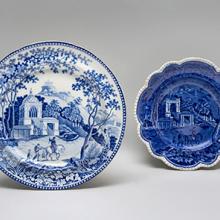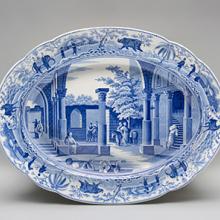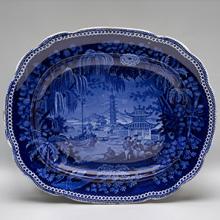International Terminal








![Jug, Tomb of the Emperor Acbar [Akbar] pattern c. 1824–30s](/sites/default/files/09_print_to_plate_sfom.jpg)



Platter, Mausoleum of Sultan Purveiz or Indian Procession pattern c. 1810–30s
Walsh
Staffordshire, England
earthenware, blue underglaze
Collection of Michael Sack
L2016.0901.062
Picturesque Views
 India officially became part of the British Empire in 1858, but was first infiltrated by the British East India Company in the early seventeenth century. As the East India Company garnered greater control over parts of the subcontinent during the mid-1700s, many British nationals moved from England to seek economic opportunities in India. Prior to the advent of the camera, British artists’ paintings, and the volumes of aquatints produced from paintings and drawings, provided the British population in Europe with a visual picture of India.
India officially became part of the British Empire in 1858, but was first infiltrated by the British East India Company in the early seventeenth century. As the East India Company garnered greater control over parts of the subcontinent during the mid-1700s, many British nationals moved from England to seek economic opportunities in India. Prior to the advent of the camera, British artists’ paintings, and the volumes of aquatints produced from paintings and drawings, provided the British population in Europe with a visual picture of India.
Picturesque landscape painting developed in the late 1700s. The style encouraged artists to study the environment in its natural state, avoiding the tame; for instance—a quaint cottage would be avoided in favor of a castle in ruins. In regard to the landscape, rugged, wild, unkempt terrain was preferred. India provided an endless source of untamed imagery for picturesque landscape artists. While Thomas and William Daniells' subject matter was novel and exotic, the manner of presentation felt familiar to British audiences. The vibrant colors of India, such as the sky, are subdued in the Daniells’ aquatints, with muted skies similar to those in England.
[inset image]
Mausoleum of Sultan Purveiz, near Allahabad Oriental Scenery 1795–1807 (Part I)
By Thomas Daniell (1749–1840) and William Daniell (1769–1837) Robert Bowyer London
Courtesy of Yale Center for British Art, Paul Mellon Collection
R2016.0902.008
Platter, Tomb of the Emperor Shah Jehan (Taj Mahal) pattern c. 1824–30s
Oriental Scenery Cartouche series
maker unknown
possibly Staffordshire, England
earthenware, blue underglaze
Collection of Michael Sack
L2016.0901.003
Taj Mahal
 The Taj Mahal, a Mughal monument and tomb, is located along the southern bank of the Yamuna (Jumna) River in Agra, India. The great Mughal emperor Shah Jahan (1592–1666), who reigned between 1628 and 1658, commissioned it in 1631 to commemorate his deceased wife. An outstanding example of Mughal architecture, it took more than twenty years to complete and is one of the most celebrated architectural structures in the world. The entirely white marble monument displays Indian, Persian, and Islamic influences.
The Taj Mahal, a Mughal monument and tomb, is located along the southern bank of the Yamuna (Jumna) River in Agra, India. The great Mughal emperor Shah Jahan (1592–1666), who reigned between 1628 and 1658, commissioned it in 1631 to commemorate his deceased wife. An outstanding example of Mughal architecture, it took more than twenty years to complete and is one of the most celebrated architectural structures in the world. The entirely white marble monument displays Indian, Persian, and Islamic influences.
In A Picturesque Tour along the Rivers Ganges and Jumna in India, the author Charles Ramus Forrest described the Taj as “of the highest beauty and interest of any structure yet raised and perfected by man in any region of the earth. It is only a tomb, it is true, and contains the mouldering remains of what was noble, powerful, and beautiful…Time with its efforts for a period of two hundred years, has as yet scarcely cast one sullying stain on its pure, lovely mass…” Describing the center chamber the author goes on to exclaim: “Description must here fail, nor can imagination figure any thing so solemnly grand, so stilly beautiful, as the scene thus suddenly presented to the view. Every tongue is mute, every sense is lost in admiration.”
[inset image]
The Taj Mahal, Tomb of the Emperor Shah Jehan and His Queen A Picturesque Tour along the Rivers Ganges and Jumna in India 1824
By Lieutenant-Colonel Charles Ramus Forrest (1750–1827)
Rudolf Ackermann
London
R2016.0901.069a
Soup tureen, Colossal Sarcophagus near Castle Rosso pattern c. 1810–30s
Caramanian series
Spode
Staffordshire, England
earthenware, blue underglaze
Collection of Michael Sack
L2016.0901.055a,b
Luigi Mayer’s Views in the Ottoman Empire
 Luigi Mayer (1755–1803) grew up in Rome and later traveled throughout the Ottoman Empire between 1776 and 1794. During this time, he produced numerous sketches and paintings of landscapes, ancient sites, and monuments. Sir Robert Ainslie (1730–1812) served as the British ambassador to Turkey in Constantinople from 1776 until 1792 and appears to have easily adapted to his new environment, even dressing in traditional Turkish clothing while living there. Ainslie acquired a large collection of drawings by Luigi Mayer, many of which he commissioned.
Luigi Mayer (1755–1803) grew up in Rome and later traveled throughout the Ottoman Empire between 1776 and 1794. During this time, he produced numerous sketches and paintings of landscapes, ancient sites, and monuments. Sir Robert Ainslie (1730–1812) served as the British ambassador to Turkey in Constantinople from 1776 until 1792 and appears to have easily adapted to his new environment, even dressing in traditional Turkish clothing while living there. Ainslie acquired a large collection of drawings by Luigi Mayer, many of which he commissioned.
When he returned to London, Ainslie compiled the images into a series of colored aquatints with the help of engraver Thomas Milton (1743–1827). They were originally published as three separate volumes. Views in Egypt appeared first in 1801; Views in the Ottoman Empire was offered next in 1803; Views in Palestine followed in 1804. The publisher later reprinted the three works together. The ceramics manufacturer Spode copied imagery from Views in the Ottoman Empire for their Caramanian dinnerware series.
[inset image]
Chestnut basket, The Chalees Satoon in the Fort of Allahabad on the River Jumna pattern c. 1810–30s
attributed to Cambrian Pottery
Swansea, Wales
earthenware, blue underglaze
Collection of Michael Sack
L2016.0901.007.01
Thomas and William Daniell in India
 The East India Company, an English company that formed in order to trade with China Southeast Asia, and India, granted Thomas Daniell and his teenage nephew permission to journey to India to work as engravers in late 1784. After traveling more than nine months, including a stopover in China, the Daniells reached Calcutta in early 1786. Thomas Daniell soon placed a notice in the Calcutta Chronicle advertising his intention to publish a set of engraved views of the city by subscription. British patrons purchased the prints for their libraries or framed them for their houses, offices, and clubs. The sale of these works helped fund the Daniells extensive travels around India to record additional sites. Printing and engraving was difficult for the Daniells to do in India. After producing the series, they focused on drawing and painting, waiting until they returned to England to produce additional aquatints. After settling back in London, Oriental Scenery their six-volume series of aquatints, each of which contained twenty-four prints, was published over several years. The seminal work greatly increased Britain’s knowledge of India, while providing British potteries with fascinating new subject matter to feature on dinnerware.
The East India Company, an English company that formed in order to trade with China Southeast Asia, and India, granted Thomas Daniell and his teenage nephew permission to journey to India to work as engravers in late 1784. After traveling more than nine months, including a stopover in China, the Daniells reached Calcutta in early 1786. Thomas Daniell soon placed a notice in the Calcutta Chronicle advertising his intention to publish a set of engraved views of the city by subscription. British patrons purchased the prints for their libraries or framed them for their houses, offices, and clubs. The sale of these works helped fund the Daniells extensive travels around India to record additional sites. Printing and engraving was difficult for the Daniells to do in India. After producing the series, they focused on drawing and painting, waiting until they returned to England to produce additional aquatints. After settling back in London, Oriental Scenery their six-volume series of aquatints, each of which contained twenty-four prints, was published over several years. The seminal work greatly increased Britain’s knowledge of India, while providing British potteries with fascinating new subject matter to feature on dinnerware.
The great Mughal emperor Akbar (1542–1605), who ruled from 1556 to 1605, commenced work on this palace-fortress at Allahabad in 1583. It was the largest fort built by the ruler and included this three-storied octagonal pavilion. The Chalis Sutun, or Hall of Forty Pillars, was situated high at the confluence of the Ganges and Jumna (Yamuna) Rivers in order to allow the cooling breezes to circulate. This print provides an important visual record of the structure, which no longer exists.
[inset image]
The Chalees Satoon in the Fort of Allahabad on the River Jumna Oriental Scenery 1795–1807
By Thomas Daniell (1749–1840) and William Daniell (1769–1837)
Robert Bowyer
London
Courtesy of Yale Center for British Art, Paul Mellon Collection T 420
R2016.0902.001
Platter, Mandarin Opaque China pattern c. 1810–30s
maker unknown
United Kingdom
ceramic, glaze
Collection of Michael Sack
L2016.0901.075
Traveling Artist William Alexander
 Traveling artists were either employed as draftsmen on voyages of exploration, or were privately financed by wealthy patrons who wished to take home images of the places they had visited. William Alexander was one such artist. He journeyed to Peking (Beijing) with the Macartney Embassy in 1793, which sought to ease trade restrictions between China and England. The slow passages along canals and rivers allowed members of the Embassy time to write in their diaries and record scenes of China. William Alexander made numerous sketches and drawings, of which over eight hundred survive. After he returned from China, he supported himself for almost eight years through the production of illustrations, watercolors, and vignettes of Chinese scenes, many of which were used by Staffordshire pottery manufacturers. Alexander’s views of China are counterparts to Thomas and William Daniell’s work in India. The Daniells also stopped briefly in Canton (Guangzhou) both before and after they traveled to India and produced painting and engravings of Chinese subjects. By coincidence, they returned to England in the same convoy of East India Company ships as the Macartney party.
Traveling artists were either employed as draftsmen on voyages of exploration, or were privately financed by wealthy patrons who wished to take home images of the places they had visited. William Alexander was one such artist. He journeyed to Peking (Beijing) with the Macartney Embassy in 1793, which sought to ease trade restrictions between China and England. The slow passages along canals and rivers allowed members of the Embassy time to write in their diaries and record scenes of China. William Alexander made numerous sketches and drawings, of which over eight hundred survive. After he returned from China, he supported himself for almost eight years through the production of illustrations, watercolors, and vignettes of Chinese scenes, many of which were used by Staffordshire pottery manufacturers. Alexander’s views of China are counterparts to Thomas and William Daniell’s work in India. The Daniells also stopped briefly in Canton (Guangzhou) both before and after they traveled to India and produced painting and engravings of Chinese subjects. By coincidence, they returned to England in the same convoy of East India Company ships as the Macartney party.
The print shown here, “View of the River Ning-Po,” by William Alexander (1767–1816) was made into an engraving by George Cooke (1781–1834). The place they are referring to, Ningpo, located in Eastern China’s Zhejiang province, is now known as Ningbo. The river they refer to is the Yong River, one of China’s main rivers, which runs through the city.
[inset image]
Digested on a New Plan Vol. 7 1808–1814
By John Pinkerton (1758–1826)
Longman, Hurst, Rees and Orme
London
R2016.0901.079.078a
Platter, Dooreahs or Dog Keepers Leading Out Dogs pattern c. 1815–30s
James & Ralph Clews
Staffordshire, England
earthenware, blue underglaze
Collection of Michael Sack
L2016.0901.066
Oriental Field Sports
 Published in London in 1807 by Edward Orme, Oriental Field Sports was written by Captain Thomas Williamson (1758–1817) with illustrations by Samuel Howitt (1765–1822). Howitt was revered for his numerous watercolors and aquatints of animals, particularly sporting scenes. Howitt’s illustrations for Oriental Field Sports were made from Williamson’s amateur sketches. A fairly common practice around the turn of the nineteenth century, amateurs often submitted their work to a professional artist to enhance and turn into finished drawings and watercolors. Williamson created the rough sketches during his twenty-year residence in Bengal. There are forty oversized aquatints in Oriental Field Sports featuring a variety of indigenous animals such as elephants, tigers, rhinoceroses, wolves, and bears. A smaller, less expensive version of the publication with simpler engravings was also offered at a later date. The text that accompanies the images mostly describes the hunting experiences of British nationals in the wilds of India. The aquatints from Oriental Field Sports provided a host of new subject matter for Spode and other ceramic manufacturers to use on dinnerware.
Published in London in 1807 by Edward Orme, Oriental Field Sports was written by Captain Thomas Williamson (1758–1817) with illustrations by Samuel Howitt (1765–1822). Howitt was revered for his numerous watercolors and aquatints of animals, particularly sporting scenes. Howitt’s illustrations for Oriental Field Sports were made from Williamson’s amateur sketches. A fairly common practice around the turn of the nineteenth century, amateurs often submitted their work to a professional artist to enhance and turn into finished drawings and watercolors. Williamson created the rough sketches during his twenty-year residence in Bengal. There are forty oversized aquatints in Oriental Field Sports featuring a variety of indigenous animals such as elephants, tigers, rhinoceroses, wolves, and bears. A smaller, less expensive version of the publication with simpler engravings was also offered at a later date. The text that accompanies the images mostly describes the hunting experiences of British nationals in the wilds of India. The aquatints from Oriental Field Sports provided a host of new subject matter for Spode and other ceramic manufacturers to use on dinnerware.
[inset image]
Dooreahs or Dog Keepers Leading out Dogs Oriental Field Sports 1807
Thomas Williamson (1758–1817) and Samuel Howitt (1765–1822) Edward Orme
London
R2016.0901.060e
Platter, Part of the City of Moorshedabad pattern c. 1810–30s
Parrot Border series
maker unknown
possibly Staffordshire, England
earthenware, blue underglaze
Collection of Michael Sack
L2016.0901.091
Charles Ramus Forrest in India
 Lieutenant-Colonel Charles Ramus Forrest (1750–1827) was an amateur artist and East India Company official. Forrest was intrigued by India and hoped to evoke the same sense of excitement in others. The artist emphasized how he drew on site while traveling along the rivers of India “and always while the magic effects of the scenes represented were still impressed on his mental vision.” He felt that the Indian landscape exceeded the scenery of Europe and displayed a “just portrait of the enchanting features of India internally glowing in the brilliant glory of the resplendent Asiatic sun.”
Lieutenant-Colonel Charles Ramus Forrest (1750–1827) was an amateur artist and East India Company official. Forrest was intrigued by India and hoped to evoke the same sense of excitement in others. The artist emphasized how he drew on site while traveling along the rivers of India “and always while the magic effects of the scenes represented were still impressed on his mental vision.” He felt that the Indian landscape exceeded the scenery of Europe and displayed a “just portrait of the enchanting features of India internally glowing in the brilliant glory of the resplendent Asiatic sun.”
Beginning in the mid-1700s, drawing became an important part of a liberal education among the British upper classes. Many drawing teachers offered lessons, and drawing and watercolor instruction books were commonplace. Engineers and surveyors were required to have drawing and watercolor skills, particularly in the field of topography and architecture. Military academies also taught drawing and painting. As a result, many civil and military officers working for the East Indian Company spent their leisure time making watercolors and sketches of their new environs. Amateur artists often had their work made into aquatints or engravings upon returning to England.
[inset image]
Part of the City of Moorshedabad A Picturesque Tour along the Rivers Ganges and Jumna in India 1824
By Lieutenant-Colonel Charles Ramus Forrest (1750–1827)
Rudolf Ackermann
London
R2016.0901.069f
Platter, Monopteros pattern c. 1810–30s
John Rogers & Son
Staffordshire, England
earthenware, blue underglaze
Collection of Michael Sack
L2016.0901.046
The Art of the Aquatint
 Inspired by the work of William Hodges (1744–97), a landscape painter whose images were made into engravings during the mid-1780s, Thomas and William Daniell travelled in India from 1786 to 1794. They produced Oriental Scenery, a collection of 144 aquatints, which were published in six volumes when they returned home to London. Publishers commonly offered books in parts over several years and invited patrons to purchase subscriptions because such volumes were expensive to produce and aquatinting was a slow, arduous process.
Inspired by the work of William Hodges (1744–97), a landscape painter whose images were made into engravings during the mid-1780s, Thomas and William Daniell travelled in India from 1786 to 1794. They produced Oriental Scenery, a collection of 144 aquatints, which were published in six volumes when they returned home to London. Publishers commonly offered books in parts over several years and invited patrons to purchase subscriptions because such volumes were expensive to produce and aquatinting was a slow, arduous process.
The aquatint technique was introduced to England from France in the mid-eighteenth century. Aquatints, which resemble watercolors, were an affordable alternative to original paintings. They also allowed artists to make sales from prints in addition to their paintings. With encouragement from his uncle, William Daniell became one of the most notable aquatinters in nineteenth-century England. For the first seven years, after he returned to England he frequently worked from early in the morning until late in the evening mastering the trade. While most artists had to give their paintings to engravers to produce prints for them, William Daniell had the unusual skills of both an artist and engraver.
[inset image]
Remains of an Ancient Building near Firoz Shah’s Cotilla, Delhi Oriental Scenery 1795–1807
By Thomas Daniell (1749–1840) and William Daniell (1769–1837)
Robert Bowyer
London
Courtesy of Yale Center for British Art, Paul Mellon Collection
R2016.0902.005
Jug, Tomb of the Emperor Acbar [Akbar] pattern c. 1824–30s
Parrot Border series
maker unknown
Staffordshire, England
earthenware, blue underglaze
Collection of Michael Sack
L2016.0901.045
Views of India on Transferware
![Tomb of the Emperor Acbar [Akbar]](/sites/default/files/inline-images/9a_print_to_plate_sfom.jpg) Illustrations, such as those by Charles Ramus Forrest, published in A Picturesque Tour along the Rivers Ganges and Jumna in India, often took years before they were made into engravings and featured in publications. Many East India Company employees might spend twenty years in India before returning to England, and in an era before steamships and railways, the journey home took months. Forrest made his drawings during his travels in India between 1807 and 1808, though his book was not published until 1824. Forrest, hoping to familiarize his audience with India, spent the first half of the book relaying a history of India.
Illustrations, such as those by Charles Ramus Forrest, published in A Picturesque Tour along the Rivers Ganges and Jumna in India, often took years before they were made into engravings and featured in publications. Many East India Company employees might spend twenty years in India before returning to England, and in an era before steamships and railways, the journey home took months. Forrest made his drawings during his travels in India between 1807 and 1808, though his book was not published until 1824. Forrest, hoping to familiarize his audience with India, spent the first half of the book relaying a history of India.
The Ganges River, located in Northern India, was the main thoroughfare for journeys between Calcutta and the upcountry. Accustomed to much smaller rivers in Europe, the mighty Ganges, and the vast subcontinent of India itself—so markedly different from England—awed British artists and writers. Many traveled up the Ganges sketching the profusion of architectural sites and varied natural landscapes they saw along the way. Artists recorded everything from ruins, mosques, and temples, to mountain ranges and rock outcrops.
[inset image]
Tomb of the Emperor Acbar [Akbar] A Picturesque Tour along the Rivers Ganges and Jumna in India 1824
By Lieutenant-Colonel Charles Ramus Forrest Rudolf Ackermann
London
R2016.0901.069d
Plates, Musketeer pattern c. 1810–30s
John Rogers & Son
Staffordshire, England
earthenware, blue underglaze
Collection of Michael Sack
L2016.0901.063, .064
Thomas and William Daniell Reach India
 Thomas Daniell and his teenage nephew William boarded the Atlas, in Gravesend, England, in April of 1785. The ship was bound for Canton (Guangzhou), since direct passages to India were difficult to secure. They reached China in August via Madeira, the Cape of Good Hope, and the Straits of Sunda. To assist them with their sketches, the Daniells used a camera obscura, an optical device that projected images onto paper that the artists could then trace. The next step entailed adding the tonal washes and finishing touches to their illustrations. After releasing their renowned series Oriental Scenery, they published the much smaller, A Picturesque Voyage to India by the Way of China.
Thomas Daniell and his teenage nephew William boarded the Atlas, in Gravesend, England, in April of 1785. The ship was bound for Canton (Guangzhou), since direct passages to India were difficult to secure. They reached China in August via Madeira, the Cape of Good Hope, and the Straits of Sunda. To assist them with their sketches, the Daniells used a camera obscura, an optical device that projected images onto paper that the artists could then trace. The next step entailed adding the tonal washes and finishing touches to their illustrations. After releasing their renowned series Oriental Scenery, they published the much smaller, A Picturesque Voyage to India by the Way of China.
The two plates displayed here illustrate the aquatint “View in the Fort, Madura,” from the second part of Oriental Scenery. Madura was capital of the Nayak Dynasty, which ruled the southernmost part of the Tamil area in the sixteenth and seventeenth centuries. Thirumalai Nayak (ruled 1623–59), the most famous of the Madurai rulers, built this stone pavilion. The pavilion motif became a popular image on both transferware and French wallpapers. The fort no longer exists.
[inset image]
View in the Fort, Madura Oriental Scenery 1795–1807
By Thomas Daniell (1749–1840) and William Daniell (1769–1837)
Robert Bowyer
London
Courtesy of Yale Center for British Art, Paul Mellon Collection
R2016.0902.006
Oval platter, Antique Fragments at Limisso pattern c. 1810–30s
Caramanian series
Spode
Staffordshire, England
earthenware, blue underglaze
Collection of Michael Sack
L2016.0901.032
Spode’s Caramanian Series
 Spode Pottery introduced their Caramanian series around 1809. Caramania historically referred to the southern coast of Turkey, known as the Turquoise Coast. Spode copied imagery from the twenty-four aquatints in Views in the Ottoman Empire (1803) for their series. The whimsical border pattern on the series, which features a number of animals, was drawn from the aquatints in Oriental Field Sports (1807). Imagery from the print “Antique Fragments at Limisso,” displayed on the piece here, may represent Kolossi Castle in Limassol, on the south coast of Cyprus in the eastern Mediterranean.
Spode Pottery introduced their Caramanian series around 1809. Caramania historically referred to the southern coast of Turkey, known as the Turquoise Coast. Spode copied imagery from the twenty-four aquatints in Views in the Ottoman Empire (1803) for their series. The whimsical border pattern on the series, which features a number of animals, was drawn from the aquatints in Oriental Field Sports (1807). Imagery from the print “Antique Fragments at Limisso,” displayed on the piece here, may represent Kolossi Castle in Limassol, on the south coast of Cyprus in the eastern Mediterranean.
Very little is known about Luigi Mayer (1755–1803), the artist whose paintings inspired Spode’s series. Sir Robert Ainslie (1730–1812), the British ambassador to Istanbul, commissioned Mayer to complete the picturesque images, which he later compiled in Views in the Ottoman Empire. Brought up in Rome, Mayer’s color-rich images and dramatic style reflect his Roman training. Watercolor was the medium of choice for many traveling artists, such as Mayer. It was easily portable and quick drying, and could be used to produce a work finished on site.
[inset image]
Antique Fragments at Limisso Views in the Ottoman Empire 1803
By Luigi Mayer (1755–1803)
R. Bowyer
London
R2016.0901.030
Platter depicting a Chinese scene c. 1815–30s
Weeping Willow Border series
James & Ralph Clews
Staffordshire, England
earthenware, blue underglaze
Collection of Michael Sack
L2016.0901.025
Views of China
 Sir George Leonard Staunton (1737–1801) arrived in China in 1792 as a member of a British delegation. Their goal was to improve trade and establish better diplomatic relations with the Chinese. At the time, China restricted economic activity with foreigners to the port of Canton (Guangzhou). Although the delegation failed in their endeavor, Staunton kept detailed notes throughout his time in China. In 1797, a two-volume account of his visit was published and later translated into French and German. The publication documented Chinese culture, customs, and artifacts at the height of the Qing dynasty (1644–1912). It also detailed the various ports of call visited en route, from Tenerife to Sumatra. The work elicited great interest and small-format editions were published in 1797; an American edition followed in 1799. Artist William Alexander (1767–1816), who traveled with the delegation, completed all of the illustrations for the publication, which were freely copied by pottery manufacturers.
Sir George Leonard Staunton (1737–1801) arrived in China in 1792 as a member of a British delegation. Their goal was to improve trade and establish better diplomatic relations with the Chinese. At the time, China restricted economic activity with foreigners to the port of Canton (Guangzhou). Although the delegation failed in their endeavor, Staunton kept detailed notes throughout his time in China. In 1797, a two-volume account of his visit was published and later translated into French and German. The publication documented Chinese culture, customs, and artifacts at the height of the Qing dynasty (1644–1912). It also detailed the various ports of call visited en route, from Tenerife to Sumatra. The work elicited great interest and small-format editions were published in 1797; an American edition followed in 1799. Artist William Alexander (1767–1816), who traveled with the delegation, completed all of the illustrations for the publication, which were freely copied by pottery manufacturers.
The platter shown here is from James & Ralph Clews’ Weeping Willow Border series. The series was made for the American market, which favored deeply colored, dark blue transferware.
[inset image]
View of the Suburbs of a Chinese City An Authentic Account of an Embassy from the King of England to the Emperor of China 1797
By Sir George Leonard Staunton (1737–1801)
Drawings by William Alexander (1767–1816) G. Nicol
London
R2016.0901.077a
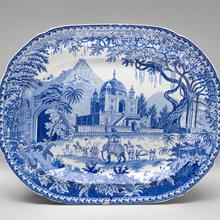
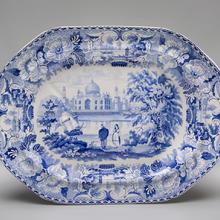
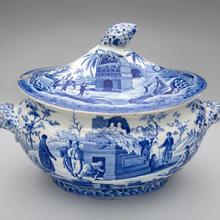
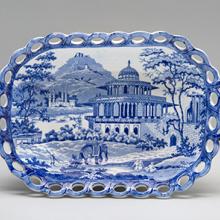
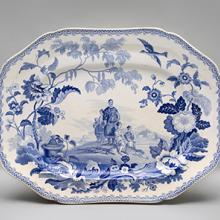
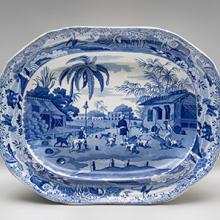
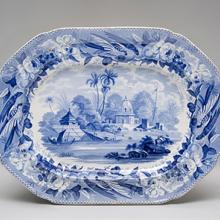
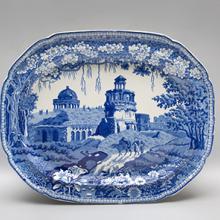
![Jug, Tomb of the Emperor Acbar [Akbar] pattern c. 1824–30s](https://www.sfomuseum.org/sites/default/files/styles/medium/public/09_print_to_plate.jpg?itok=4HnJ4Sqs)
